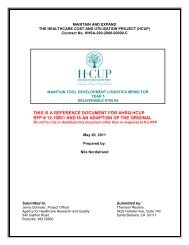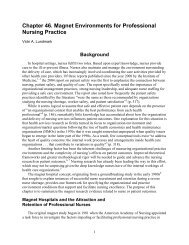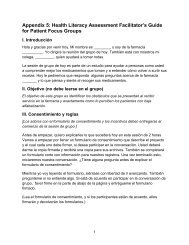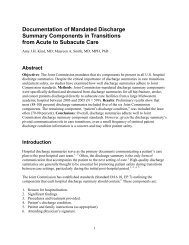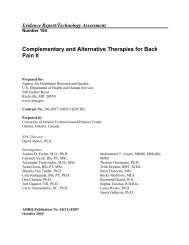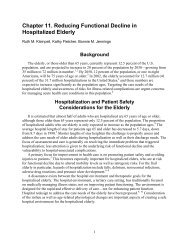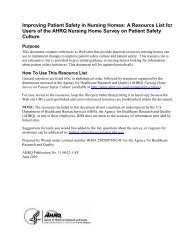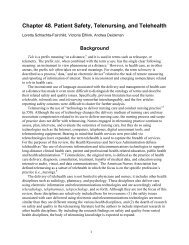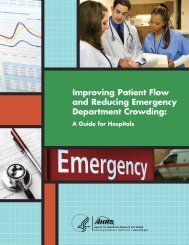Emergency Severity Index (ESI): A Triage Tool for Emergency ...
Emergency Severity Index (ESI): A Triage Tool for Emergency ...
Emergency Severity Index (ESI): A Triage Tool for Emergency ...
Create successful ePaper yourself
Turn your PDF publications into a flip-book with our unique Google optimized e-Paper software.
Chapter 5. The Role of Vital Signs in <strong>ESI</strong> <strong>Triage</strong><br />
within a presentational flow chart. The vital-sign<br />
parameter is one of the factors that help the triage<br />
nurse assign an acuity level.<br />
Vital signs are not always the most in<strong>for</strong>mative<br />
method to determine triage acuity. At least one<br />
study has suggested that vital signs are not always<br />
necessary in the initial assessment of the patient at<br />
triage. In 2002, Cooper, Flaherty, Lin, and Hubbell<br />
examined the use of vital signs to determine a<br />
patient's triage status. They considered age and<br />
communication ability as factors. Twenty-four<br />
different U.S. emergency departments and more<br />
than 14,000 patients participated in that study. Final<br />
results demonstrated that vital signs changed the<br />
level of triage acuity status in only eight percent of<br />
the cases. When further examining individual age<br />
groups, pediatric patients aged 2 or younger showed<br />
the largest variation in triage decision with an 11.4percent<br />
change once vital signs were collected.<br />
Using Vital Signs with <strong>ESI</strong><br />
<strong>Triage</strong><br />
Using <strong>ESI</strong> triage, the only absolute requirement <strong>for</strong><br />
vital signs assessment at triage is <strong>for</strong> patients who<br />
meet level-3 criteria. Vital sign assessment at triage is<br />
optional <strong>for</strong> patients triaged as <strong>ESI</strong> level 1, 2, 4, or 5.<br />
While the <strong>ESI</strong> system does not require vital signs<br />
assessment on all patients who present to triage,<br />
local policies may dictate a different procedure.<br />
Factors such as staffing levels, case mix, and local<br />
resources influence individual hospital policies<br />
regarding vital signs at triage and are beyond the<br />
scope of this handbook. In general when triaging a<br />
stable patient, it is never wrong to obtain a set of<br />
vital signs, unless you delay placement to obtain<br />
vital signs. The developers of the <strong>ESI</strong> and the current<br />
<strong>ESI</strong> research team believe that experienced ED nurses<br />
can use vital sign data as an adjunct to sound<br />
clinical judgment when rating patients with the <strong>ESI</strong>.<br />
There is limited evidence on the ability of abnormal<br />
vital signs to predict serious illness. The <strong>ESI</strong> has been<br />
revised over time to reflect changes in the available<br />
evidence and recommendations from the literature.<br />
The <strong>ESI</strong> working group initially used the systemic<br />
inflammatory response syndrome (SIRS) literature<br />
(Rangel-Frausto et al., 1995) in developing the<br />
danger zone vital sign box and accompanying<br />
footnotes.<br />
The first version of the <strong>ESI</strong> used the SIRS criteria to<br />
include a heart rate of greater than 90 (<strong>for</strong> adults) as<br />
an absolute indicator to up-triage from <strong>ESI</strong> level 3 to<br />
36<br />
level 2 (Wuerz, Milne, Eitel, Travers, Gilboy, 2000).<br />
The SIRS research was based on predictors of<br />
mortality in an intensive care unit population.<br />
Based on an excess of false positives using these<br />
criteria <strong>for</strong> ED patients at the initial <strong>ESI</strong> hospitals,<br />
the heart rate cutoff was changed to 100 in <strong>ESI</strong><br />
version 2, and nurses were instructed to consider uptriage<br />
to <strong>ESI</strong> 2 <strong>for</strong> adult patients with heart rates<br />
greater than 100 (Gilboy, Tanabe, Travers, Eitel,<br />
Wuerz, 2003; Wuerz et al., 2001). Additionally,<br />
pediatric vital signs were added to the danger zone<br />
vital signs box (American College of <strong>Emergency</strong><br />
Physicians [ACEP], 2003).<br />
When using <strong>ESI</strong> as a triage system, vital signs<br />
assessment is not necessary in the triage area <strong>for</strong><br />
patients who are immediately categorized as level 1<br />
or 2. If the patient appears unstable or presents with<br />
a chief complaint that necessitates immediate<br />
treatment, then transport of the patient directly to<br />
the treatment area should be expedited. For these<br />
patients, the resuscitation team is responsible <strong>for</strong><br />
obtaining and monitoring vital signs at the bedside.<br />
This would include patients that have clinical<br />
appearances that indicate high risk or need <strong>for</strong><br />
immediate cardiovascular or respiratory<br />
intervention. These patients may appear pale,<br />
diaphoretic, or cyanotic. The triage nurse always has<br />
the option to per<strong>for</strong>m vitals in the triage area, if an<br />
open bed is not immediately available or if he or she<br />
feels that the vital signs may assist in confirming the<br />
triage acuity level.<br />
Some patients may not be identified initially as <strong>ESI</strong><br />
level 1 until vital signs are taken. For example, an<br />
awake, alert elderly patient who complains of<br />
dizziness might be found to have a life-threatening<br />
condition when a heart rate of 32 or 180 is<br />
discovered during vital sign measurement. In this<br />
case, the patient should be assigned <strong>ESI</strong> level 1 no<br />
matter how “good” the patient appears.<br />
As shown in the <strong>ESI</strong> algorithm in Chapter 2, if<br />
patients do not meet <strong>ESI</strong> level-1 or level-2 criteria,<br />
the triage nurse comes to decision point C. The<br />
nurse then determines how many resources the<br />
patient is expected to need in the ED. If the patient<br />
is expected to need one or no defined resources, he<br />
or she can be assigned an <strong>ESI</strong> level of 4 or 5 and no<br />
vital sign assessment is necessary. But if the patient<br />
is expected to need two or more resources, then the<br />
nurse comes to decision point D and vital signs<br />
should be assessed.<br />
Vital signs can play a more important role in the<br />
evaluation of some patients at triage, especially






